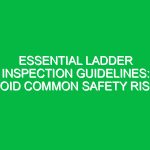“`html
Essential Ladder Safety Guidelines: Avoid Common Risks & Stay Safe
Good morning team,
Today, we’re going to discuss a critical aspect of Workplace Safety: ladder Safety. Ladders are a common tool used in various work environments, but they can also pose serious risks if not used correctly. It’s essential to understand the guidelines that can help us avoid accidents and ensure our Safety. Let’s dive into the essential ladder safety guidelines that will keep us all safe while working at heights.
Understanding Essential Ladder Safety Guidelines
Essential ladder safety guidelines refer to the set of Best Practices designed to mitigate risks and ensure safe ladder usage. Understanding these guidelines is crucial because improper ladder use can lead to falls, injuries, or even fatalities. Safety isn’t just a priority—it’s a necessity for all of us.
Common misconceptions include the belief that any ladder can be used for any job. In reality, different tasks require specific types of ladders, and using the wrong one can increase the risk of accidents. By adhering to ladder safety guidelines, we can significantly reduce these risks and protect ourselves and our colleagues.
Key Hazards, Risks, and Safety Considerations
When it comes to ladder safety, several Hazards and risks need to be addressed:
- Improper Ladder Selection: Using the wrong type of ladder for the task can lead to instability and accidents.
- Overreaching: Stretching too far while on a ladder can cause loss of balance and falls.
- Faulty Ladders: Using damaged or worn ladders can lead to serious injuries.
- Improper Setup: Failing to set up a ladder on stable, level ground can compromise safety.
Ignoring these safety protocols can lead to real-world consequences, such as serious injuries that may require time off work, lead to increased insurance premiums, and even result in legal action against the company. It is crucial that we take these hazards seriously.
Best Practices, Procedures, & Actionable Advice
To ensure ladder safety, follow these best practices:
1. Choose the Right Ladder
Always select the appropriate ladder for the job. Ensure it has the right height and weight rating. For instance, if you need to reach a height of 12 feet, use a ladder that allows you to safely reach that height without overreaching.
2. Inspect the Ladder Before Use
Prior to using a ladder, inspect it for any signs of damage such as cracks, bent rungs, or loose hardware. If you notice any faults, do not use the ladder and report it to your supervisor.
3. Set Up Properly
When setting up a ladder, ensure it is placed on stable, level ground. The base should be positioned one foot away from the wall for every four feet of height. This is known as the 4-to-1 rule.
4. Maintain Three Points of Contact
Always maintain three points of contact when climbing a ladder. This means two hands and one foot or two feet and one hand should be in contact with the ladder at all times. This practice helps maintain balance and stability.
5. Don’t Overreach
Never lean too far to the side while on a ladder. If you can’t reach the area you are working on, climb down and reposition the ladder to ensure your safety.
6. Use Personal Protective Equipment (PPE)
Wear appropriate PPE while using ladders, such as hard hats and non-slip shoes, to further protect yourself from potential hazards.
Case Studies
Let me share a couple of real-world incidents where ladder safety guidelines were not followed:
- In one instance, an employee fell while trying to reach an overhead pipe, having improperly positioned the ladder. This led to a serious injury and highlighted the importance of proper ladder placement.
- Another case involved a worker who used a damaged ladder, resulting in a fall that could have been avoided with a thorough inspection. This incident served as a reminder to always check equipment before use.
Regulations, Standards, and Compliance
Adhering to ladder safety guidelines is not just about personal safety; it’s also about compliance with Regulations. The Occupational Safety and Health Administration (OSHA) has established standards regarding ladder usage that we must follow:
- osha Standard 1926.1053: This standard covers the safety requirements for ladders used in construction and emphasizes the importance of proper Maintenance and usage.
- ANSI A14.2: This American National Standards Institute standard provides guidelines for the selection, use, and maintenance of portable ladders.
Compliance with these regulations is critical as it helps protect employees and the company from potential liabilities. Remember, following these guidelines not only keeps you safe but also contributes to a culture of safety within our organization.
Employee Engagement & Discussion
Before we wrap up, let’s open the floor for discussion. Here are a few questions to consider:
- What safety challenges have you encountered related to ladder use?
- Have you ever felt unsafe while using a ladder? What could have made it safer?
Your insights and experiences are valuable. Sharing them can help us all learn and adapt our practices for improved safety.
Conclusion & Key Takeaways
To conclude, let’s quickly summarize the key points we’ve discussed today:
- Always choose the right ladder for the job.
- Inspect ladders before use to ensure they are safe.
- Set up ladders correctly and maintain three points of contact.
- Stay compliant with OSHA and ANSI regulations.
By applying these essential ladder safety guidelines, we can significantly reduce risks and create a safer workplace for everyone. Remember, safety is a shared responsibility, and each of you plays a crucial role in maintaining a safe working environment.
Thank you for your attention and commitment to safety today. Let’s all prioritize safety and support each other in creating a culture of care!
“`


